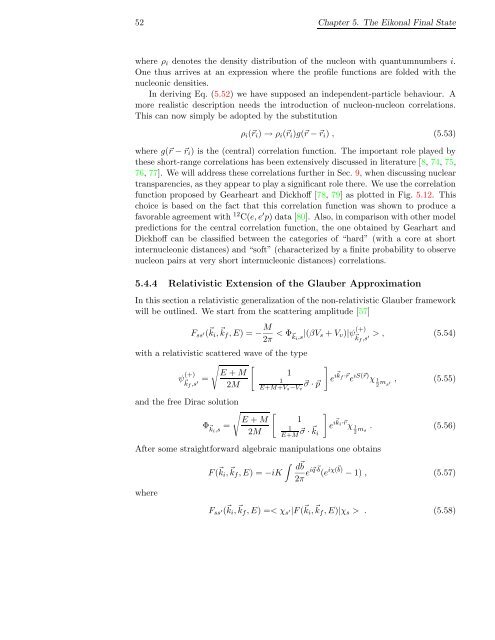Download Thesis in Pdf Format - Theoretical Nuclear Physics and ...
Download Thesis in Pdf Format - Theoretical Nuclear Physics and ...
Download Thesis in Pdf Format - Theoretical Nuclear Physics and ...
You also want an ePaper? Increase the reach of your titles
YUMPU automatically turns print PDFs into web optimized ePapers that Google loves.
52 Chapter 5. The Eikonal F<strong>in</strong>al State<br />
where ρ i denotes the density distribution of the nucleon with quantumnumbers i.<br />
One thus arrives at an expression where the profile functions are folded with the<br />
nucleonic densities.<br />
In deriv<strong>in</strong>g Eq. (5.52) we have supposed an <strong>in</strong>dependent-particle behaviour. A<br />
more realistic description needs the <strong>in</strong>troduction of nucleon-nucleon correlations.<br />
This can now simply be adopted by the substitution<br />
ρ i (⃗r i ) → ρ i (⃗r i )g(⃗r − ⃗r i ) , (5.53)<br />
where g(⃗r − ⃗r i ) is the (central) correlation function. The important role played by<br />
these short-range correlations has been extensively discussed <strong>in</strong> literature [8, 74, 75,<br />
76, 77]. We will address these correlations further <strong>in</strong> Sec. 9, when discuss<strong>in</strong>g nuclear<br />
transparencies, as they appear to play a significant role there. We use the correlation<br />
function proposed by Gearheart <strong>and</strong> Dickhoff [78, 79] as plotted <strong>in</strong> Fig. 5.12. This<br />
choice is based on the fact that this correlation function was shown to produce a<br />
favorable agreement with 12 C(e, e ′ p) data [80]. Also, <strong>in</strong> comparison with other model<br />
predictions for the central correlation function, the one obta<strong>in</strong>ed by Gearhart <strong>and</strong><br />
Dickhoff can be classified between the categories of “hard” (with a core at short<br />
<strong>in</strong>ternucleonic distances) <strong>and</strong> “soft” (characterized by a f<strong>in</strong>ite probability to observe<br />
nucleon pairs at very short <strong>in</strong>ternucleonic distances) correlations.<br />
5.4.4 Relativistic Extension of the Glauber Approximation<br />
In this section a relativistic generalization of the non-relativistic Glauber framework<br />
will be outl<strong>in</strong>ed. We start from the scatter<strong>in</strong>g amplitude [57]<br />
F ss ′( ⃗ k i , ⃗ k f , E) = − M 2π < Φ ⃗ ki ,s |(βV s + V v )|ψ (+)<br />
⃗ kf ,s ′ > , (5.54)<br />
with a relativistic scattered wave of the type<br />
√ [<br />
ψ (+)<br />
⃗ = E + M 1<br />
kf ,s ′ 1<br />
2M E+M+V s−V v<br />
⃗σ · ⃗p<br />
<strong>and</strong> the free Dirac solution<br />
√ [<br />
Φ ⃗ki ,s = E + M<br />
2M<br />
]<br />
]<br />
1<br />
1<br />
E+M ⃗σ · ⃗k i<br />
After some straightforward algebraic manipulations one obta<strong>in</strong>s<br />
where<br />
∫<br />
F ( ⃗ k i , ⃗ k f , E) = −iK<br />
e ı⃗ k f ·⃗r e ıS(⃗r) χ 1<br />
2 m s ′ , (5.55)<br />
e ı⃗ k i·⃗r χ 1 . (5.56)<br />
ms<br />
2<br />
d ⃗ b<br />
2π ei⃗q·⃗b (e iχ(⃗ b) − 1) , (5.57)<br />
F ss ′( ⃗ k i , ⃗ k f , E) =< χ s ′|F ( ⃗ k i , ⃗ k f , E)|χ s > . (5.58)















